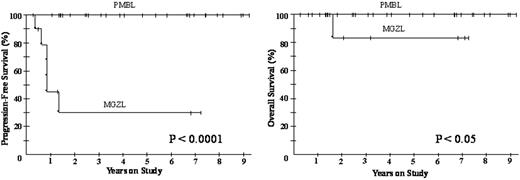Abstract
Abstract 106
Mediastinal B-cell lymphomas (MBCL) are a clinical-pathologically related group, putatively derived from thymic B-cells, and include PMBL, Nodular Sclerosis Hodgkin Lymphoma (NSHL) and MGZL. PMBL and NSHL contain significant molecular overlap, and MGZL has pathological features intermediate between PMBL and NSHL. Overlapping clinical features include young age, female predominance and localized mediastinal presentation. The risk of local failure after anthracycline-based therapy has led to routine mediastinal radiation (RT) in PMBL and bulky NSHL, suggesting relative chemo-resistance. Anecdotal reports also suggest MGZL is relatively resistant to Hodgkin-based chemotherapy. Thus, better systemic therapy is needed to avoid RT and its risk of secondary malignancies and cardiac disease, and to improve cure. Clinical studies suggest PMBL and NSHL are particularly responsive to dose-intense strategies. We prospectively compared untreated PMBL and MGZL for the first time and assessed if the dose-intense DA-EPOCH-R regimen would obviate the need for RT and improve cure. DA-EPOCH-R was administered 6-8 cycles and FDG-PET was used in pts with residual masses to assess need for biopsy and RT (n=31). PMBL and MGZL had similar clinical characteristics shown below. PMBL and MGZL IHC, respectively, had similar CD20+ 100% both; CD10+ 5% and 0%; BCL6+ 86% and 100%; and MUM1+ 58% and 67%; but different CD30+ 71% and 100% (P=0.14) and CD15+ 0% and 60% (P=0.0009). At 4 years median F/U, PFS and OS were 100% for patients with PMBL without RT (table below). Comparison to historical PMBL (n=17) treated with DA-EPOCH (PFS 65% and OS 77% at 10 years) indicated a significant benefit of rituximab (PFS: P=0.0012) and (OS: P=0.013). MGZL outcome with DA-EPOCH-R was significantly worse than PMBL (PFS 30% and OS 83% at 4 years) and 50% required mediastinal RT (figure below). FDG-PET + and - predictive value for relapse were 62% and 95%, respectively. In conclusion, DA-EPOCH-R is highly effective in PMBL and obviates RT whereas MGZL shows greater chemo-resistance. Rituximab adds significant benefit to PMBL. We hypothesize that MGZL and NSHL are more chemo-resistant than PMBL and may share molecular mechanisms of drug resistance. Novel therapeutic strategies, such as targeting the microenvironment, are needed in these diseases. Comparative gene expression profiling is underway.
| Characteristics . | PMBL (35) . | MGZL (11) . |
|---|---|---|
| Gender (F/M) | 23:12 | 4:7 |
| Median Age (range) | 32 (19-52) | 34 (14-52) |
| Median Mass cm (range) | 10.9 (5-16.8) | 10.8 (6.2-19.7) |
| ECOG PS > 1 | 1 (3%) | 1 (9%) |
| Stage III or IV | 11 (31%) | 1 (9%) |
| LDH > Normal | 25 (71%) | 7 (64%) |
| Extranodal Sites | 21 (60%) | 4 (36%) |
| Pleural Effusion | 17 (48%) | 2 (18%) |
| IPI Score > 2 | 4 (11%) | 1 (9%) |
| Characteristics . | PMBL (35) . | MGZL (11) . |
|---|---|---|
| Gender (F/M) | 23:12 | 4:7 |
| Median Age (range) | 32 (19-52) | 34 (14-52) |
| Median Mass cm (range) | 10.9 (5-16.8) | 10.8 (6.2-19.7) |
| ECOG PS > 1 | 1 (3%) | 1 (9%) |
| Stage III or IV | 11 (31%) | 1 (9%) |
| LDH > Normal | 25 (71%) | 7 (64%) |
| Extranodal Sites | 21 (60%) | 4 (36%) |
| Pleural Effusion | 17 (48%) | 2 (18%) |
| IPI Score > 2 | 4 (11%) | 1 (9%) |
No relevant conflicts of interest to declare.
Author notes
Asterisk with author names denotes non-ASH members.


This feature is available to Subscribers Only
Sign In or Create an Account Close Modal